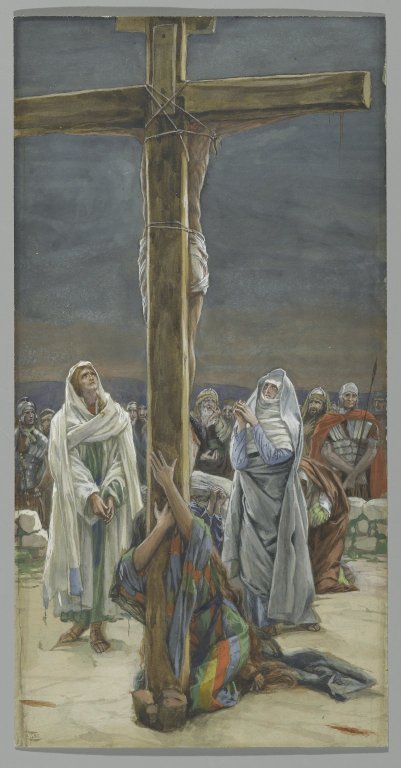[Greek] ἀδελφός (adĕlphŏs), [Latin] frater: brethren, brother, male sibling, fellow believer, kinsman; 319 scriptural references

Woman Behold Your Son (Stabat Mater): painting my James Tissot (1836-1902)
Background Information:
Greek Hellenism: This term, meaning “from the same womb” (delphys), also refers to the son of the same mother, kinsman, tribesman, colleague, associate, pair (anything double), and an affectionate address to others. Xenophon’s Memorabilia 2.3.19 states, “A pair of brothers, in my judgment were made by God to render better to serve on the other than a pair of hands, feet, and eyes,” Plato’s Menex 239a states, “We and our people being all born of one mother, claim to be neither master seek lawfully legal equality, virtue, and understanding.” Xenophon’s Anabasis 7.2.25 states, “He promised that if I should bring the army to you, he would not only treat me in all ways as a friend and brother, but would give me the place on the seacost of which you hold possession.”
Old Testament: This term means brother, any blood-relation or kinsman, one having the same national ancestor, and countryman. This term can refer to both physical brotherhood and spiritual brotherhood. The Christian community later will adopt this notion of spiritual brotherhood. Interestingly, the Hebrew and Aramaic languages do not have a corresponding term for cousin. Therefore, the term brother (in a general sense) took on the meaning for cousin or kinsman.
I do not renounce the noble kinship that binds me to my brothers (4Macc.10:3). We have ventured to send word to you for the renewal of brotherhood and friendship (1Macc.12:10). Now, then if you think well of me, give me leave to visit my brothers (1Sam.20:29). We are relatives of Ahaziah (2Kgs. 10:13). Moses saw an Egyptian striking a Hebrew, one of his own kinsmen (Exo.2:11). Let me return to my kindred in Egypt (Exo.4:18). Creditors shall remit all claims on loans made to a neighbor, not pressing the neighbor, one who is kin (Deut.15:3)
New Testament: This term refers to both physical brotherhood (strict sense) and spiritual brotherhood (general sense). This term can refer to brother, countryman, man, fellow believer, and associate. Physical brotherhood is often illustrated in genealogy, situational circumstances, and parables (teaching stories). Jesus calls His disciples (and hearers) His brethren. Aramaic was the native language spoken by Jesus. On the cross Jesus gives His Mother to the beloved disciple saying “Woman, behold your son…Behold, your mother.” The disciple represents the Church. Mary is the mother of the Church.
“Is he not the carpenter, the son of Mary, and the brother of James and Joes and Judas and Simon?” Mk.6:3
This mention of “brother” references Jesus’ relationship with His kinsman.
“The servant said to him, ‘Your brother has returned and your father has slaughtered the fattened calf because he has him safe and sound.” Lk. 15:7
This is a parable of a father who welcomes his wayward son. This parable depicts the Father.
“When Jesus was His mother and the disciple there whom He loved, He said to His mother, ‘Woman, behold your son.’ Then He said to the disciple, ‘Behold your mother.’ And from that hour the disciple took her into his home.” Jn. 19:26-27
The disciple represents the Church. Mary is the Mother of the Church.
Possible dolphin/womb connections: The ancient Greeks believed Delphi to be the center (navel/womb) of the earth. Apollo was believed to have taken on the form of a dolphin. The ancient Greeks view dolphins as womb shaped, “womb fish”, and “our brothers of the sea.” The Dauphin of France was the title given to the heir apparent of the throne of France. A dolphin is depicted on the coat of arms.
Philadelphia: William Penn (1644-1718) bought land from the local Lenape tribe. As a Quaker Penn had experienced religious persecution and wanted his colony to be a place where anyone could worship freely. Penn made a friendship treaty with the chief Lenape Tammany at what is known as Fishtown neighborhood in the city of Philadelphia.
Conclusion:
Philadelphia, fraternal
It was interesting to discover how the word brother (“from the same womb”) is directly related to the womb (delphys). In addition, there are also links between brothers, wombs and dolphins. It is also important to note that this term can apply beyond a direct physical sense.
The Old Testament provides ample examples of brotherhood in terms of national ancestry and kinship. This begins the important notion of spiritual brotherhood. This will later continue in Christianity. It is also important to note that there is no established word for cousin.
In the New Testament, Jn.19:26-27 plays an important role in defining the relationships of Jesus, Mary, and the Church. Jesus gives Mary to the disciple (who represents the Church). And by extension, Jesus also gives Mary to us. Therefore, Mary is also our Mother.
Stabat Mater: [Latin]: the Mother was standing
Oh brother! Unfortunately, there exists a certain percentage of Christians (and non-Christians) who believe that Mary physically had other children. It does not make sense that Mary would have other children (in the natural way) and be exposed to humanity’s sinful nature. It would make better sense that Jesus would be born in a perpetually sin-free womb of Mary. Mary is also considered to be the Ark (vessel) of the New Covenant. Jesus gave His mother to the disciple. This action of Jesus would have been considered a great insult (if in fact Jesus had other brothers through Mary). Since Jesus had no direct brother, He gave His mother to the disciple.
